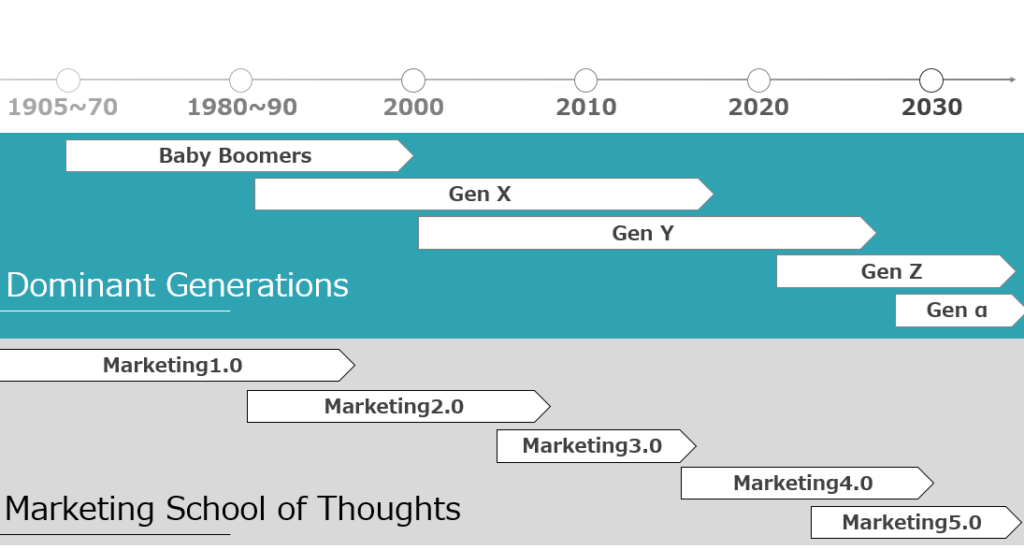Five years have passed since the release of “Marketing 4.0,” which also triggered the birth of transcosmos’ (hereafter referred to as “our company”) “5A Loyalty Diagnosis” service. The latest book in the series, “Marketing 5.0,” was released in Japanese on April 20, 2022. Marketing 5.0 discusses generational and social challenges in the digital society and new tactics for utilizing marketing technology. In this series of articles, we will provide a chapter-by-chapter overview in an easy-to-understand manner.
In Part 2, we summarize the “Generation Gap”.
Contents
The challenge of catering to different generations
What generations make up the employees of your company? What generation does your company’s product currently target?
In Marketing 5.0, we talk about five generations that are the scope of the U.S. Baby Boomers, Generation X, Generation Y, Generation Z, and the Alpha Generation. They are the Baby Boomers, Generation X, Generation Y, Generation Z, and the Alpha Generation. Although the generation of the Baby Boomers was born in a different era than the Baby Boomers, who are referred to in the same way in Japan, this is a bold distinction for a book that has been read globally. On the other hand, Generation Z, which has been the focus of much attention from today’s marketers, is perhaps the most common classification worldwide.
In Marketing 5.0, we provide a variety of examples of generational differences in attitudes, noting that every generation is shaped by different sociocultural environments and life experiences. At the same time, preferences and attitudes toward products and services also differ from generation to generation, forcing marketers to respond with different offerings, customer experiences (CX), and even different business models. Generational segmentation is one of the most common ways to segment markets, but let’s look at each of the five generations first.
5 Generations
①Baby Boomers
This generation was born between 1946 and 1964. The term “baby boom” was used to describe the high birth rates in the United States and many other countries after the end of World War II. With post-war security and a booming economy, many couples wanted to have children, making them the primary target market for marketers at the time. Although this generation experienced economic hardship in the later years, their size and the booming U.S. economy of the time made them one of the major economic forces in the country. Today they are aging and will have healthier and longer lives.
②Generation X
Generation X is those born between 1965 and 1980. Sandwiched between the more populous Baby Boomers and Generation Y, this generation has been called the “forgotten middle child” because they are under the radar of marketers. As a “middle child” group, Generation X has experienced major changes in consumer technology and is therefore considered highly adaptable. They grew up watching music videos on MTV and listening to tapes on their Walkmans as adolescents, and as adults, they turned to CDs and streaming. They occupy most leadership roles in businesses today, making them one of the most influential generations in the workforce.
③Generation Y
Born between 1981 and 1996, Generation Y has been the most controversial generation of the past two decades. Coming of age in the new millennium, they are widely known as the “Millennial Generation.” They are the first generation to be strongly associated with the use of social media and were familiar with the Internet from a young age. On social media, they feel the need to express themselves, share with their peers, and compare themselves with their peers to gain approval. They are therefore heavily influenced by what their peers say and buy. They do a lot of research and purchases online using their smartphones, but they don’t buy as many products as older generations, indicating a preference for experience over ownership.
④Generation Z
Marketers around the world are turning their attention to Generation Z, born between 1997 and 2009 when the Internet was already mainstream. Like Gen Y, they are heavy users of social media, but unlike the idealistic Gen Y, Gen X is said to be more pragmatic. In other words, Gen Z prefers to portray themselves as they are, as opposed to Gen Y, who likes to post images of themselves that are more sophisticated than they are, using filters. Today, Gen Z has already surpassed Gen Y to become the most populous generation in the entire world, and by 2025, most of Gen Z will make up the labor force and will therefore be the most important market for most products and services.
⑤The Alpha Generation
The Alpha Generation is the newest, consisting of people born between 2010 and 2025. raised by Generation Y and influenced by Generation Z, the Alpha Generation has been actively consuming content on MOBILE devices from an early age. They are at home playing with high-tech toys, smart devices, and wearable devices. Today, the Alpha Generation does not yet have huge purchasing power, but it does have a strong influence on the spending of its parents.
Generation Gap and Marketing Evolution
Marketing is constantly evolving to adapt to an ever-changing marketplace.

Marketing 1.0 – Product-centric
Product-centered marketing began in the United States in the 1950s. It was developed primarily to cater to the affluent baby boom generation and their parents.
Marketing 2.0 – Customer-centric
It spread in the early 1980s when the saving attitudes of the late baby boomers and Generation X became a challenge for marketers and greatly reduced consumer purchasing power.
Marketing 3.0 – Human-centric
Generation Y demanded that companies create products, services, and cultures that have a positive social and environmental impact.
Marketing 4.0 – From Traditional to Digital
Generations Y and Z have adapted to a digitalized society, and the paths they follow to purchase have changed, with post-purchase recommendations being the most important indicator.
Marketing 5.0 – Technology for Humanity
With the emergence of Generation Z and Generation Alpha, it is time to evolve once again as “Marketing 5.0.” To keep up with Generation Z and Generation Alpha, marketers must continue to adopt the next technologies to enhance human lives. Marketing 5.0 will be the integration of Marketing 3.0 (human-centric) and Marketing 4.0 (the enabler of technology).
Summary
Which generation is your company targeting today and for the future? Not many companies understand the unique needs of each generation and have the systems in place to address all of them. In the coming decade, companies that can gain the trust of Generation Z and Generation Alpha will have a strong competitive edge. To do so, companies need to fully understand the gaps and preferences of each generation and consider whether their brands and products are meeting their needs.

